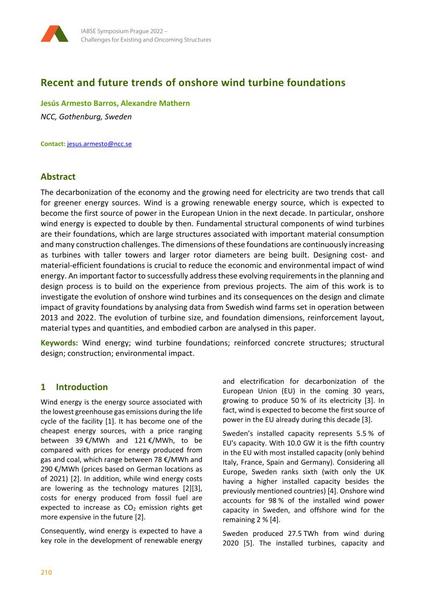Recent and future trends of onshore wind turbine foundations

|
|
|||||||||||
Détails bibliographiques
| Auteur(s): |
Jesús Armesto Barros
(NCC, Gothenburg, Sweden)
Alexandre Mathern (NCC, Gothenburg, Sweden) |
||||
|---|---|---|---|---|---|
| Médium: | papier de conférence | ||||
| Langue(s): | anglais | ||||
| Conférence: | IABSE Symposium: Challenges for Existing and Oncoming Structures, Prague, Czech Republic, 25-27 May 2022 | ||||
| Publié dans: | IABSE Symposium Prague 2022 | ||||
|
|||||
| Page(s): | 210-217 | ||||
| Nombre total de pages (du PDF): | 8 | ||||
| DOI: | 10.2749/prague.2022.0210 | ||||
| Abstrait: |
The decarbonization of the economy and the growing need for electricity are two trends that call for greener energy sources. Wind is a growing renewable energy source, which is expected to become the first source of power in the European Union in the next decade. In particular, onshore wind energy is expected to double by then. Fundamental structural components of wind turbines are their foundations, which are large structures associated with important material consumption and many construction challenges. The dimensions of these foundations are continuously increasing as turbines with taller towers and larger rotor diameters are being built. Designing cost- and material-efficient foundations is crucial to reduce the economic and environmental impact of wind energy. An important factor to successfully address these evolving requirements in the planning and design process is to build on the experience from previous projects. The aim of this work is to investigate the evolution of onshore wind turbines and its consequences on the design and climate impact of gravity foundations by analysing data from Swedish wind farms set in operation between 2013 and 2022. The evolution of turbine size, and foundation dimensions, reinforcement layout, material types and quantities, and embodied carbon are analysed in this paper. |
||||
| Copyright: | © 2022 International Association for Bridge and Structural Engineering (IABSE) | ||||
| License: | Cette oeuvre ne peut être utilisée sans la permission de l'auteur ou détenteur des droits. |
||||
